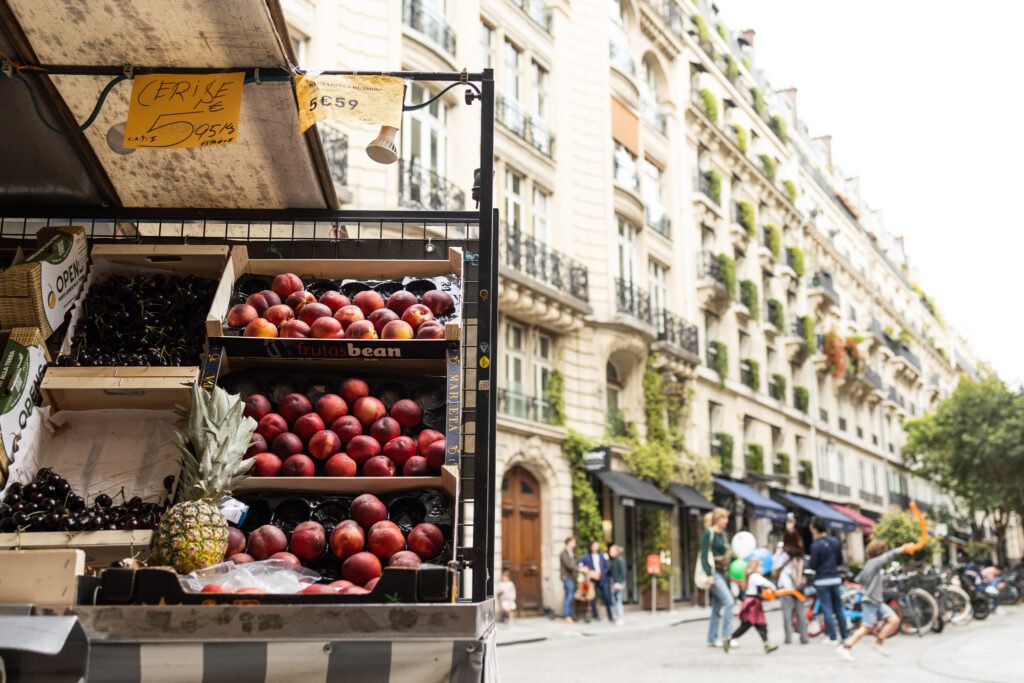It can be confusing to find necessities like groceries and water during your first time visiting Europe. Europeans get their groceries from local markets, smaller (and possibly unfamiliar) European grocery stores, and convenience stores. Surprisingly, it is much easier to find fresh produce in Europe than it is in the United States. While traveling through Spain, Italy, and Budapest, I found groceries at small local grocers and convenience stores and never saw a supermarket. So in this travel guide, we’ll show you exactly how to grocery shop like a European.

Grocery Shopping in Europe: How to find food, water, and other necessities
Where can I expect to find grocery items while traveling in Europe?
In Europe, it is far easier to access fresh produce and groceries than in the US. When I traveled in Europe, I found that it was easy to find unprocessed food in small shops on street corners. There are many convenience stores and nearby shops that carry grocery items and fresh produce. However, you may have to get creative! The food ingredients are, at times, pretty random.
Groceries are easy to access because European cities are less spread out and easily walkable so people shop more frequently there. They might stop by a local market on their walk home from work to grab something.
In the United States, we have super markets where people go to the to buy everything they need once a week. In Europe however, people go more frequently to get fresh food from local grocers and markets close to home. Many European grocery stores resemble what we’re used to in the U.S., however. Lidl is a common grocery store we’ve seen across Europe, from Budapest to Paris to Lisbon.
What obstacles will I encounter while grocery shopping in Europe?
In big US cities, there is no shortage of giant supermarkets that sell every food a typical American would expect. This is not the case in Europe, where there are independent local markets who sell specific items. These vendors sell goods at street markets and indoor food markets. These vendors tend to sell during limited hours and they have a limited selection so it isn’t always easy to find what you’re looking for when grocery shopping abroad. There are also specialty food shops like bakeries and butcher shops that sell very specific items during limited hours. Convenience stores offer some grocery items and are often open 24 hours a day.
It can be difficult to find specific items sometimes. We had problems finding cleaning products and paper towels in Barcelona, and salt in Budapest. Fruit and vegetable options can in some cases be more limited in Europe because vendors only sell produce that is in season. This is because Europeans care more about the quality of produce more than they care about having produce available at all times.
What can I expect to find in European convenience stores? How are they different from convenience stores in the US?
In the United States, convenience stores aren’t usually stand alone stores. They are attached to gas stations which are placed in areas with a lot of vehicle traffic and aren’t within walking distance. In Europe, there is almost always a convenience store that is within walking distance from wherever you’re staying. These convenience stores are rarely attached to gas stations, which are located outside of the city where there is vehicle traffic. European convenience stores sell snacks, drinks, basic personal care items, cigarettes, and other random consumer goods just like US stores do. The main difference between is that convenience stores sell more fresh produce than US convenience stores.
However, when it comes to groceries in European convenience stores— you’re more likely to find eggs and pears than basic ingredients like salt or rice! So if you’re facing empty cabinets, cooking can be difficult. At the beginning of your stay, I would suggest that you go to a day-time market and get cooking basics. Kitchen items like paper towels, trash bags, and dish soap are also difficult to find. I still have no idea where you can find paper towels or trash bags. I don’t remember seeing paper towels or trash bags in any of the stores— and I was there for five weeks. If you know where a tourist can find these items, comment down below.
Can you drink the tap water in Europe?
The tap water in Europe is entirely safe to drink. People in Europe almost exclusively drink bottled water, however. Unlike in the United States, it isn’t the norm to give every customer water at restaurants. You have to specifically order it. The server then brings a large glass bottle of water and gives everyone at the table cups. You can ask for tap water at some restaurants, but others might not give it to you. I found this odd but I wasn’t annoyed by it. I was almost always splitting a bottle of water with other people and they were only between three and five euros, it didn’t matter that it wasn’t free.
In Europe, there are almost no water fountains and very few public restrooms. If you need to use a bathroom your best bet is to go to a restaurant, museum, or train station. As someone who constantly drinks water, I found this to be very frustrating at first! Luckily, there are many apps that can be used to track where the nearest public restroom is. And I was able to stay hydrated by carrying around a big bottle of water that I bought from a convenience store. Sometimes there are vending machines in train stations with bottled water, but this is rare. I would suggest carrying water with you at all times.
Is alcohol cheaper than water in Europe?
Shockingly to some Americans, it is sometimes cheaper to order a glass of wine at a restaurant than it is to order water, especially if dining alone. In Spain and Italy, a glass of wine is often only a few euros. If a restaurant only sells large bottles of water, it may be sightly cheaper to order alcohol instead.
Alcohol is cheaper in Europe than it is in many other parts of the world. This is because most European countries don’t adjust the price of alcohol for inflation. So alcohol is becoming cheaper in comparison to other goods in the European economy. Wine is also much cheaper in Europe since a lot of wine is made there. Around 60% of all wine production takes place in Europe. Due to the plentiful supply and the lack costs associated with imported goods, it is much cheaper there than it is in other parts of the world. The average price of a bottle of wine in Portugal is $4. In the United States, a bottle of wine is $13 on average.
It is much easier to access alcohol in Europe than it is in the Western world. In the United States, the drinking age is 21- not 18 (or even 16 in some countries). There are also many regulations on the sale of alcohol.
As Texans, the 24hr access to liquor in Europe was shocking to us. In Texas, you can’t buy liquor in convenience stores, you have to go to a liquor store to buy liquor and they’re only open until 9pm. Also liquor stores in Texas are closed on Sunday and there are dry counties in Texas where no alcohol can be bought or sold. After prohibition, Texas passed a series of “Blue Laws” that placed additional restrictions on alcohol. For example, you can’t buy liquor on Thanksgiving Day, Christmas Day or New Year’s Day. And if Christmas Day or New Year’s Day falls on a Sunday, liquor stores have to be closed the following Monday.
Where can I find fast food in Europe?
There aren’t a lot of fast food restaurants in Europe. For a health nut like me, this was a dream come true. There are so many more healthy options when you are roaming the streets late at night after the bars. If you’re craving a taste of familiarity, fear not— almost every city we’ve visited so far has had a McDonald’s, KFC, Burger King, and Starbucks.
By the bars, there are also sometimes Greek food places with gyros and kebabs. It is usually just as easy, if not easier, to go to a convenience store and grab something. There are processed snacks and also fast, random meal options in these stores. Many convenience stores are open 24 hours.
The most prevalent type of fast food in Europe is halal restaurants. These spots are often open late and usually serve gyro pita wraps and plates. They’re not the best quality of food, but they definitely get the job done.
While I was in Barcelona, a midnight run to the convenience store resulted in me walking away with a bottle of cava, grapes, breadsticks, and cheese. However, the options available really vary from store to store. This specific market had a lot of food options.
Why Produce In Europe Tastes Better
Fruit and vegetables in Europe are often said to taste better than those in the US. This is because in the US, farmers are focused on getting crops with the highest yield rather than flavor. Both Italy and France actually have government regulated quality assurance programs for food and wine. Foods that are approved by the government’s quality assurance program get a seal of approval.
In my opinion, the produce in the US is not as good as produce in Europe overall. But if you go to a nice grocery organic store like Whole Foods, the produce is just as good. The overall quality of produce in the US may be less because US farmers, in line with consumer preference, are breeding crops to be larger. There is little research on this, but I hypothesize that farmers have figured out how to pump water into crops and grow larger produce that is less flavorful.
To test if genetically modified produce is less flavorful, go to a US supermarket and buy 1 regular sized avocado and 1 “jumbo” sized avocado. The regular-sized avocado will be more flavorful than the larger one. I am not sure how this is the case. But in Europe they do not genetically modify produce in this same way.
My Personal Experience Grocery Shopping in Europe:
I loved the fruit shops in Europe. When Ethan and I were in Barcelona, we went into a fruit shop that was owned by a family from China. It was very cool how multicultural the city was. There were fruits everywhere that I had never seen before. In one fruit shop, the cashier didn’t speak any English. We ended up buying a fruit without having any idea what it was. It was the size of an avocado, the skin was green and was patterned with hexagonal indentions.
We tried to google what the unknown fruit was but couldn’t find anything. After cutting it open, we found that there were round black seeds dispersed throughout white meat. The seeds were like papaya seeds— but larger. The white meat inside the fruit had the same consistency of an avocado but was white and tasted very sweet. We thought that the fruit was really good. Other fruits that we got from the shop included papaya and some of the most beautiful strawberries we had ever seen.
There were so many fruit stores in Europe that there was almost always access to fresh fruit. When I was stranded at a train station in a small beach town outside of Viterbo, Italy, there was a fruit shop with no air conditioning that sold fruits of all kinds. I bought a bag of apricots, plumbs, and cherries then went into the train station restroom and rinsed them off. They were delicious and were the perfect snack for a hot summer day.




This is my first time pay a quick visit at here and i am really happy to read everthing at one place
Wow, incredible blog structure! How lengthy have you been blogging
for? you make blogging look easy. The whole glance of your web site is
magnificent, as well as the content material!
You can see similar here dobry sklep
I’ve been following this blog for years and it’s amazing to see how much it has grown and evolved Congratulations on all your success!